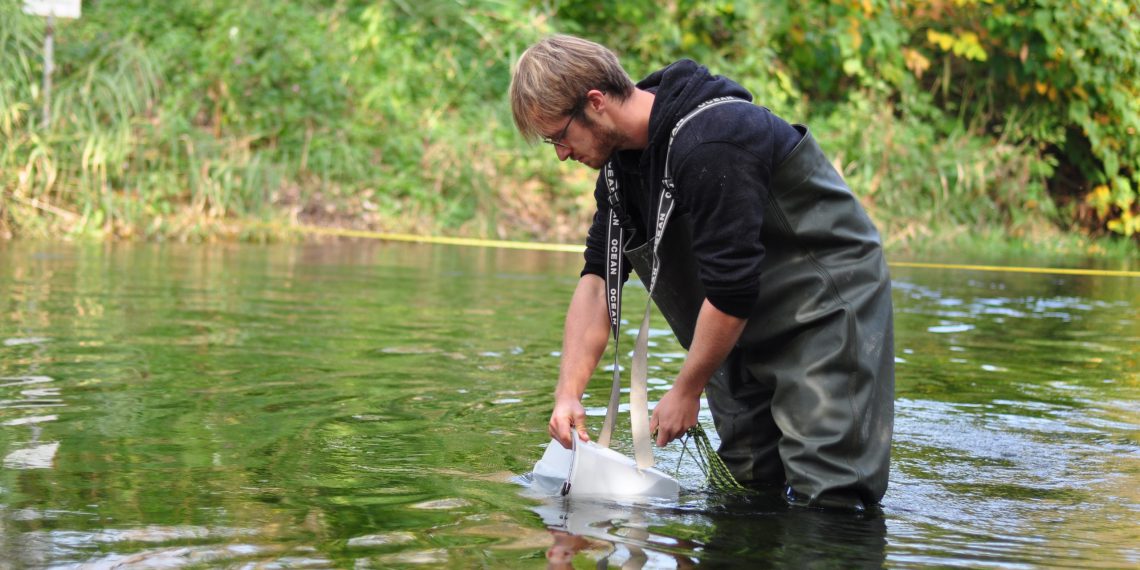In a study published in the high-ranking journal Earth-Science Reviews, David Piatka of Friedrich-Alexander-Universität Erlangen-Nürnberg and other authors from the AquaKlif project, which is funded by the Bavarian Network for Climate Research, examine the role of dissolved oxygen in rivers. Its continuous input is necessary for organisms living in the water and is endangered by many factors. Using global measurement data, the study shows that because rivers integrate the biogeochemical information of entire catchments, their oxygen dynamics can provide important clues about the “health” of surrounding ecosystems and landscapes.
Dissolved oxygen is one of the most important elements for the majority of aquatic life — but equally a scarce commodity because its solubility is limited. Water temperature, flow gradient in streams and rivers, and adjacent land use affect oxygen levels in streams and their sediments. Stream bottom sediments, in particular, are important habitat for numerous aquatic and aquatic-dwelling species, where quite a few animals spend the egg or larval stage. The authors summarize the major sources and sinks of dissolved oxygen in river systems and discuss its role in adjacent lakes, reservoirs, soils, and groundwater.
“After the literature search required for a review paper, our own analyses were exciting, in which we worked with Romy Wild of the Technical University of Munich to evaluate more than 170,000 dissolved oxygen measurement data from the Global River Chemistry database. In this way, we learn not only about the living conditions in the river and on its banks, but also what the situation is like in the many small tributaries and their surroundings. With this method, we can even estimate how intact nature is there for the entire catchment area. Extensive analysis of the available data suggests that climate warming may become critical for aquatic ecosystems simply because of lower oxygen solubility in warmer waters.”
- David Piatka, lead author
The researchers conclude by suggesting ways to further improve monitoring of rivers — which are often seen as “integrators of entire landscapes.” In addition to high-resolution concentration measurements, better knowledge of residence times and sources and sinks of oxygen are important. Newer methodological tools such as stable isotopes, iron conversion analysis, biological studies, and measurement of radon gas dissolved in water can help. These techniques are currently being developed and applied in the AquaKlif project.
“The article brings to light many facts about dissolved oxygen in rivers for the first time on a global and continental basis” emphasizes Prof. Johannes Barth, in whose Applied Geology group David Piatka is doing his PhD. “It is equally important to study the conversion of this vital element in detail. What do balances look like in small rivers, how is oxygen transported into sediments and at what rates is it converted there? These are crucial questions for local functioning of aquatic ecosystems.” These water-bound communities are also close to the heart of Prof. Jürgen Geist of the Technical University of Munich: “The availability of dissolved oxygen is of crucial importance for living organisms in water bodies. The article has succeeded in providing a holistic and global view of the importance and conversion processes of oxygen in water bodies. From an understanding of these processes, important indicators of the state of aquatic systems can be derived.”
“Our article in the renowned journal Earth-Science Reviews is a successful example of joint approaches in the collaborative project, which brings together expertise from geosciences, hydrology and biology and can thus propose innovative methodological approaches” says hydrologist Prof. Dr. Stefan Peiffer from the University of Bayreuth, who represents the AquaKlif project as spokesperson.

















